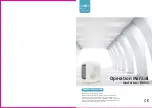
14
ENG
15
ENG
3.3.3 INDOOR UNIT INSTALLATION
- Insert and screw down a nut on each supporting
rod.
- Lift the indoor unit and insert the rods in the
holes provided on the mounting brackets.
- Place a washer and nut on each of the rods.
- Level out the machine and fix it tightening so that
nuts are pressed against each other.
- It is advisable to place a lock nut against the
lower nut on the suspension rods.
- This indoor unit has been originally designed for
installation on false ceilings. Where the unit is to
be mounted on a location with easy access, the
electric wiring bar must be protected to prevent
hazardous situations.
3.3.4 DRAIN PIPE INSTALLATION
- Special care should be taken when laying drain
tubing, otherwise if any problem occurs the con-
densed water of the evaporator could spill.
- Do not place the drain pipe in an upwards posi-
tion otherwise drain water would go back to the
unit and spill when the unit would stop.
- Do not connect the drain pipe to the sanitary
drains, waste water drains or any other drain
facility if a trap is not installed.
- When a common drain pipe is connected to other
indoor units, connection positions of each unit
should be at a higher level than the common
pipe. The common pipe length should be appro-
priate for the size and number of existing units.
3.3.5 SUSPENSION OF THE INDOOR UNIT
Hang up the indoor unit as shown in the figure below.
Parts supplied by the filter:
- Suspension Rod, Nut and Washer
3.3.1 INITIAL CHECK
- Install indoor unit allowing for enough clearance
around the unit so there is room for handling and
maintenance operations as shown below.
- Avoid any obstacles that could impair air take-up
or discharge flow.
- Do not install the indoor unit in a machinery
workshop or in a kitchen where oil or smoke
mist could flow into the indoor unit. Oil would
be deposited in the heat exchanger resulting in
a reduced unit performance. Also, internal plastic
parts could be deformed or they could even break
as a result.
- Note the following items when the indoor unit is
to be installed in a hospital or premises where
electromagnetic waves from medical equipment
may be present.
A) Do not install the indoor unit where electromag-
netic waves directly impinge on the electric box,
the remote control switch or the remote control
cable.
B) Install the unit as far as possible from the elec-
tromagnetic wave source. A 3 metre clearance
should be arranged.
C) Install a noise filter when the power supply pro-
duces disturbing noises.
D) Select final location and direction of the indoor
unit paying special attention to tubes, cables and
maintenance.
E) When selecting the indoor unit location, the air
ducting network should be borne in mind in order
to facilitate distribution.
3.3.2 FIXING THE UNIT
- Use the appropriate fasteners for each structure
type paying special attention to any possible
transmission of vibrations and noise. Noise or
vibration proof items should be provided if it is
considered to be necessary.
NO
TE:
Is very important the positio-
ning of a siphon in each water-
drainage.
400
200
500
3- INDOOR UNIT INSTALLATION
3.3 DUCTS: INDOOR UNIT








































